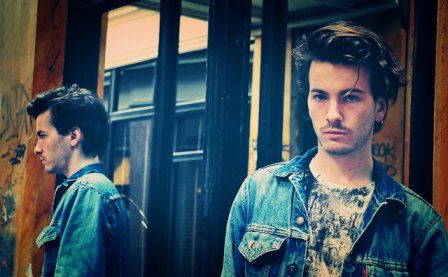“Did she have a precursor? She did, indeed she did … Ladies and gentlemen of the jury, exhibit number one is what the seraphs, the misinformed, simple, noble-winged seraphs, envied. Look at this tangle of thorns.”
– Vladimir Nabokov, Lolita
When fashion had finally finished mining punk, sometime in the late 90s, it looked around for subcultures yet to be exploited. It found goth. When I say exploited, I don’t mean to imply that this is a bad thing — pop will eat itself, after all. But such an adoption, a changeling, is of necessity a mimicry.
At the same time, strange things were happening in the world of goth itself. Hard-hitting electronic (and often cheesy) dance music made a controversial entrance into clubs, spawning newschool Electronic Body Music (EBM) groups like Covenant and Wolfsheim. To the horror (and not in a good way) of those who wanted to keep their Danse Society exclusive, tripping the dark fantastic to Fields Of The Nephilim or, at a pinch, Corpus Delicti, the darkwave dance floor became a den of double doofs. Industrial’s experimental origins were stripped away. The Pony was born, and with it a cottage industry in hair falls, goggles, and the stripping-down of raver high-vis to mere patches on oversized pants. A fifth column in anime and otoku culture, Gothic Lolita (“my sin, my soul”) captured the popular imagination.
That revival took longer to wend its way into music, though. With the exception of frontrunner dark-post-punkers like Interpol, it’s only in more recent years that we’ve seen the rise (and fall — viz. Altered Zones) of revivals of goth genres of all kinds, from Joy Division and Bauhaus clones (the bass that launched a thousand drips) to surfers of a possibly-inexistent minimal wave.
The interesting thing now, though, is that the music’s not actually happening in goth subculture. Your average proto-hipster in 2000 would look at you like you were mad if you mentioned “Dead Stars,” while the EBM scene existed in its separate subcultural bubble, with small general purchase anywhere outside Germany. Rather than emerging from goth culture, those cold-seeking missiles who got lost on the information superhighway found themselves in various highways and byways where they liked the scenery and decided to settle down — and really, who can blame them?
Enter Trust. Their 2012 debut, TRST, was stunning, precisely because it took a familiar genre in the process of being repurposed for the indie mainstream and twisted it just a little. It was enough to defamiliarize and render depressingly delightful the EBM pattern through the judicious deployment of “found sound” effects, creating a weirdly unsettling yet somehow perfect tension between known and unknown and the disturbingly off-kilter boy-girl vocals. That, and it had all the hooks.
Cut to 2014, and Joyland has the former set of ingredients, but the latter has been subject to decay. Most tracks are urgent dancefloor stompers — particular standouts are “Icabod” and lead single “Rescue, Mister” — but with the departure of Maya Postepski to focus on dark synth-poppers Austra, something else seems absent.
Robert Alfons’ decision to maintain the high-low vocals through chipmunking is arresting (“I broke her spell by incarnating her in another”). In the absence, though, of the gritty murk of TRST and the intimations of a world of malformed sonic objects outside the techno-primitive beat, there’s a quality of the streamlined on Joyland that calls out for irritation. A joyful Alfons, then, is no longer sulking; but where before he had us in Heaven, we are now in Hell, with Dante and Geryon. Joy, to be sure, is an odd and novel thing.
“Now, Geryon, get up! Be sure
To make your circles wide and move down slowly:
Remember the strange weight that you now carry.”



